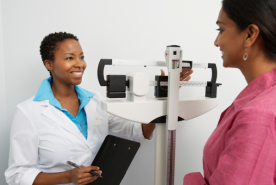Food safety is important for everyone, especially for those who have received a transplant. Not handling foods safely can lead to food borne illness (commonly referred to as food poisoning). Food borne illness can be very serious, even deadly, so food safety must be part of your daily routine. Transplant patients are at higher risk since they take immunosuppressive medications or “anti-rejection medications” to protect the new transplanted kidney, but these medicines leave you more susceptible to illness.
There are many types of bacteria that can cause food borne illness. The most common types are E. coli, Listeria and Salmonella. Food borne illness can occur when there is contamination of a food at any point during the preparation process. It is important to know that some food choices are more "risky" than others.
Foods that provide the most risk include
- Raw or undercooked eggs and foods that contain them
- Raw or undercooked pork, beef, chicken, fish and shellfish
- Prepared spreads (i.e. smoked salmon, seafood type)
- Unpasteurized milk, cheese or yogurt
- Unpasteurized juices and cider
- Raw sprouts, such as alfalfa and bean
- Unwashed raw fruits, vegetables or salads
- Sliced deli meats, cheeses and deli salads (The risk these foods carry depends on how they have been processed, stored and prepared. Tip: heating deli meats can make them safe to eat.)
To be on the safe side, it is recommended that these foods should be avoided. However, check with your transplant dietitian for recommendations specific to you, as recommendations may vary depending upon your transplant program and the type of transplant you have received.
Even when you are careful to avoid the high risk foods, proper handling of all foods is key in preventing illness. When it comes to food safety, there are many common mistakes. To prevent illness, take care to avoid the following:
- Unwashed hands
- Unclean cutting boards
- Shared knife for raw meats and vegetables
- Countertop thawing
- Marinating meats at room temperature
- Inadequate or undercooking
- Tasting food with the stirring spoon while cooking
- Leftovers/doggie bags left at room temperature
- Extended time at room temperature from purchase to home refrigerator
Fortunately, it is possible to avoid these pitfalls by following four basic principles that have been established by the United States Department of Agriculture (USDA). The points of emphasis are Clean, Separate, Cook and Chill.
Clean
Always start with clean hands and kitchen surfaces, as bacteria can be any where in the kitchen. Wash your hands in warm, soapy water for at least 20 seconds before you begin preparing your food. Cutting boards, knives and other utensils should be washed thoroughly in hot soapy water before and after use. Be sure to wash all fruits and vegetables thoroughly before eating. Also, be sure to clean all canned food lids before opening.
Separate
Bacteria can be spread from one food to another, so be sure to use one cutting board for fresh produce and another one for raw meats, poultry and fish. Never put cooked food back on the plate that you had placed raw meat on prior to cooking. Also, don’t reuse any marinade that came into contact with raw meats unless you bring it to a boil first.
Cook
Always cook foods to their proper temperature. Don’t guess at whether or not it is done. Always use a food thermometer to make sure that foods have reached their desired temperature to ensure that they are safe. Use the following chart as a guide.
| Food Type | Minimum Internal Temperature |
|---|---|
| Steaks & Roasts | 160 degrees |
| Fish | 145 degrees |
| Pork | 160 degrees |
| Ground Beef | 160 degrees |
| Egg Dishes | 160 degrees |
| Chicken | 165 degrees |
Chill
Refrigerate all foods promptly to slow the growth of harmful bacteria. It is best to put all foods in shallow containers to promote quicker cooling in the refrigerator. The refrigerator should be at or below 40 degrees while the freezer should be at or below 0 degrees. All perishable food items should be refrigerated within 2 hours of cooking them (or 1 hour if it is above 90 degrees outside).
Remember food safety concerns when shopping for food. Don’t buy food that is past the "sell-by", "use-by" or any other expiration date. Check food packages carefully for leaks. Place meats, poultry and fish in plastic bags before putting them in your cart to avoid contamination of other foods in the cart. Make sure frozen foods feel frozen and refrigerated foods feel cold. Select these foods last so they can maintain a safe temperature until you can get home to put them away. This is important to avoid having food temperatures in the Danger Zone of 40 to 140 degrees. Bacteria can multiply quickly in foods that are in this temperature range for greater than 2 hours.
When dining out, seek clean and well-maintained restaurants. Ask that solid meats be cooked to at least medium and ground meats to medium-well.
There are many symptoms of food borne illness. These symptoms include nausea, vomiting, abdominal cramps, diarrhea and fever. If you suspect food borne illness, be sure to seek medical advice immediately.
Well water from private or public wells should be avoided for drinking. Bathing and cooking with well water is generally safe; however, ensure the water is tested frequently for bacteria and boil for at least a minute before cooking.
Remember that as a transplant patient, food safety is extremely important. Basic food safety principles have been outlined here but use the listed references below for additional information.
References:
Food Safety for Transplant Recipients – United States Department of Agriculture
Food Safety: A Need-to-Know Guide for Those At Riskhttp://www.fsis.usda.gov/PDF/Kitchen_Companion.pdf
http://www.fda.gov/downloads/Food/FoodborneIllnessContaminants/UCM312793.pdf
If you would like more information, please contact us.
© 2019 National Kidney Foundation. All rights reserved. This material does not constitute medical advice. It is intended for informational purposes only. Please consult a physician for specific treatment recommendations.








